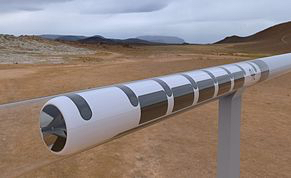The Future of Long Distance Transportation
Or just a billionaire’s pipe dream?

Hyperloop UPV photo via Wikimedia Commons under Creative Commons license
Hyperloop Makers UPV
First announced in 2012 by billionaire Elon Musk, the Hyperloop is a new mode of transportation that from its birth has faced some problems.
Although the Hyperloop currently faces some problems, its creation will offer a new advanced form of travel, should it come to fruition. Companies of the system, like Hyperloop One, are making strides to bring the vehicle to commercial use.
For those unfamiliar with The Hyperloop, it is a form of travel propelled in a reduced pressure tube levitated by a linear electric motor. Much like a regular motor, which relies on electromagnetic forces, a linear motor is made up of a stator, the stationary part of the motor and a rotor, the part which moves.
Attached to the rotor is an aerodynamic body, also known as a pod. When the vehicle is complete the pod is what will hold the Hyperloop’s passengers . When an electric current is passed through the stator it produces a magnetic field which is able to levitate and move the metal rotor forward bringing passengers to their destination.
According to Bruce Upbin, the Vice President of Strategic Communications at Hyperloop One, “The aerodynamic design will help… reduce energy consumption in the low-pressure vacuum environment.” Due to the Hyperloop’s lack of wheels, this technique of magnetic thrust allows for an economically efficient ride. It is cheaper because there is less friction. Therefore, it will use less energy.
Due to this efficient design, Hyperloop One, along with other Hyperloop companies, claim that the vehicle can reach speeds of up to 700 miles per hour. But no Hyperloop company has yet reached this goal. According to Business Insider, in August of 2017 the highest recorded speed was 192 miles per hour from Hyperloop One, and then later in the month a joint effort from SpaceX and Tesla constructed a pod which reached 220 miles per hour. That speed is not very close to the target speed. Meaning, Hyperloop companies still have to deal with a few engineering challenges before their claims of moving from city to city in less than an hour are met.
With the Hyperloop potentially reaching speeds near 700 miles per hour and traveling with groups of people, the safety of the vehicle comes into question. At the moment the Hyperloop One website claims that minimal safety issues will occur because the Hyperloop is “fully autonomous, so there is no driver related error” and the vehicle will “have multiple emergency braking techniques, triggering an immediate braking of the vehicle.”
The Hyperloop One site proposes that in the event of a life threatening injury, the Hyperloop will come supplied with a ” full suite of life support systems” which should diminish the possibility of injury to riders.
As for comfort, on Hyperloop One’s website the company says riding on the Hyperloop is “about the same as riding in an elevator or a passenger plane.” Despite the vehicle’s speed reaching close to 700 miles per hour, it’s a smooth ride.
The most prevalent challenge facing the construction of all Hyperloops at this time is the need for government approval and safety regulation. Currently only two companies have gotten support from state government: Elon Musk’s own Hyperloop company The Boring Company and Hyperloop One. At the moment, only Hyperloop One has constructed an actual track on public land.
As for safety regulations, Hyperloop One claims on their website “we have already begun the early stages of the certification process and look forward to continuing our work with regulators….” The company is making strides to bring its vehicle to public use.
Through federal, state, and local government, Hyperloop One has finished tube installation “on the 1,600-foot-long DevLoop, which will be the world’s first full-scale Hyperloop when system testing begins in the coming months” according to Leslie Horwitz, a Strategic Communications Manager at Hyperloop One.
While Hyperloop One has a long way to go until it is used by the public, which the company predicts to be 2021, what was once a dream of Elon Musk is now closer to reality.

Cam, this year's Production Manager, is a member of the class of 2020 and joined the Green Wave Gazette his sophomore year as a Staff Writer with a special...
